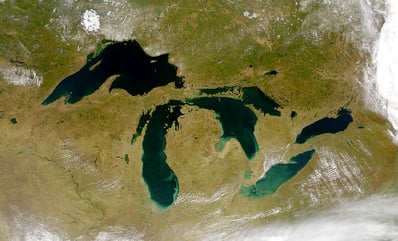Who, as a child, has not at least entertained the idea of tying a note to a balloon and sending it out into the great beyond, or scrolling a message in a bottle and tossing it into the sea? The thought of something we authored soaring over the landscape or riding the tides to eventually connect with someone far away is almost as thrilling as going on an adventure ourselves. It may be this innate desire for exploration and connection beyond our backyards—beyond our borders—that has led to the timeless popularity of the children’s books written by Holling C. Holling.
Holling Clancy Holling , originally named Holling Allison Clancy, was born in Michigan in 1900. His Midwestern roots, his studies at the Art Institute of Chicago, and his work at the Field Museum of History in Chicago all helped to inform the themes pervasive in his writing. A survey of his books includes a number of classic and award winning titles.
Paddle-to-the-Sea
Paddle-to-the-Sea was published in 1941, and in the ensuing seventy-five years it has never been out of print. In 1942 it received the Caldecott Honor Book award. The book tells the story of a First Nation boy in Canada who carves a figure, resembling himself, in a toy canoe. He equips the vessel with a rudder and ballast and scratches the following message on it: “Please put me back in the water. I am Paddle-to-the Sea.” He then perches it on a snow- covered creek bed and waits for “Sun Spirit” to set it free.
With the help of many along the way (who add their own messages to the original carving), the canoe travels through all of the Great Lakes, to the sea, and eventually across the sea on a ship en route to France. On this last leg of the journey, the figure hangs above the bunk of another young boy who, in reference to the carving, “. . . liked his smile. It made Paddle look as though he had seen many things and understood them all.”
The boy who set it afloat in the first place gets word of Paddle-to-the-Sea’s successful journey. As he sets out in his own canoe, he pauses mid-paddle, mimicking the pose of his carving, and quietly takes great satisfaction in having sent Paddle-to-the-Sea out into the world with a name from his father’s lodge.
Each page of the book recounts a different portion of the trip and also includes information about the nature of the Great Lakes and the industries and people that inhabit their shores.
Seabird
Seabird was published in 1948 and received the Newbery Medal Honor in 1949. This book, too, uses a carving as a vehicle for telling the story. Ezra, a cabin boy on a whaling ship, sees an ivory seabird flying in an unusual pattern. The movements alert him to an iceberg ahead, which saves the ship and its crew from certain disaster. Later, he trades for two ivory walrus tusks from an Eskimo and uses them to carve a replica of the bird. His shipmates offer him treasures from seas all over the world to help craft the details of his masterpiece. It is this bird that accompanies him on his future journeys and witnesses the history of sea travel from the early whalers to clippers and steamships, and eventually jet airplanes that leave “no wake across the sky.” The even numbered pages in the book tell the story, while the odd relay information about sea life. Wide margins provide a canvas for drawings that depict both historical events and facts about natural history.
Minn of the Mississippi
The journey theme continues in yet another award winning book by Holling C. Holling. Minn of the Mississippi received the Newbery Honor Award in 1952, a year after its publication. Minn, a snapping turtle, follows the instinctual voice within her telling her to “BREAK OUT” so that she can “continue growing in a wider world. . .” Minn does hatch, grow, and travel—the full length of the Mississippi River! The river bed displays artifacts of the culture on its shores as it carries Minn to the Gulf of Mexico. Again, text and margin drawings contain information, this time about wildlife, cities, dams, and bridges.
 Tree in the Trail
Tree in the Trail
In another book by Holling, Tree in the Trail, a lone Cottonwood stands stoically along what would later be known as the Santa Fe Trail. It witnesses over three hundred years of history beginning with Coronado’s search for Gold in 1540 and ending with the commercial trail that would eventually be the Santa Fe Railroad. For the bulk of the story, the tree, though stationary, is exposed to the natural world and the people and animals that inhabit it.
As young (and even not-so-young) readers of Holling’s books, we, too become witnesses to adventures that broaden our understanding of geography, history, and natural science. His stories are like cleverly disguised textbooks. I imagine generations of children have enjoyed them, blissfully unaware that they have just read something educational. Parents and teachers, I entreat you, let that be our little secret.










